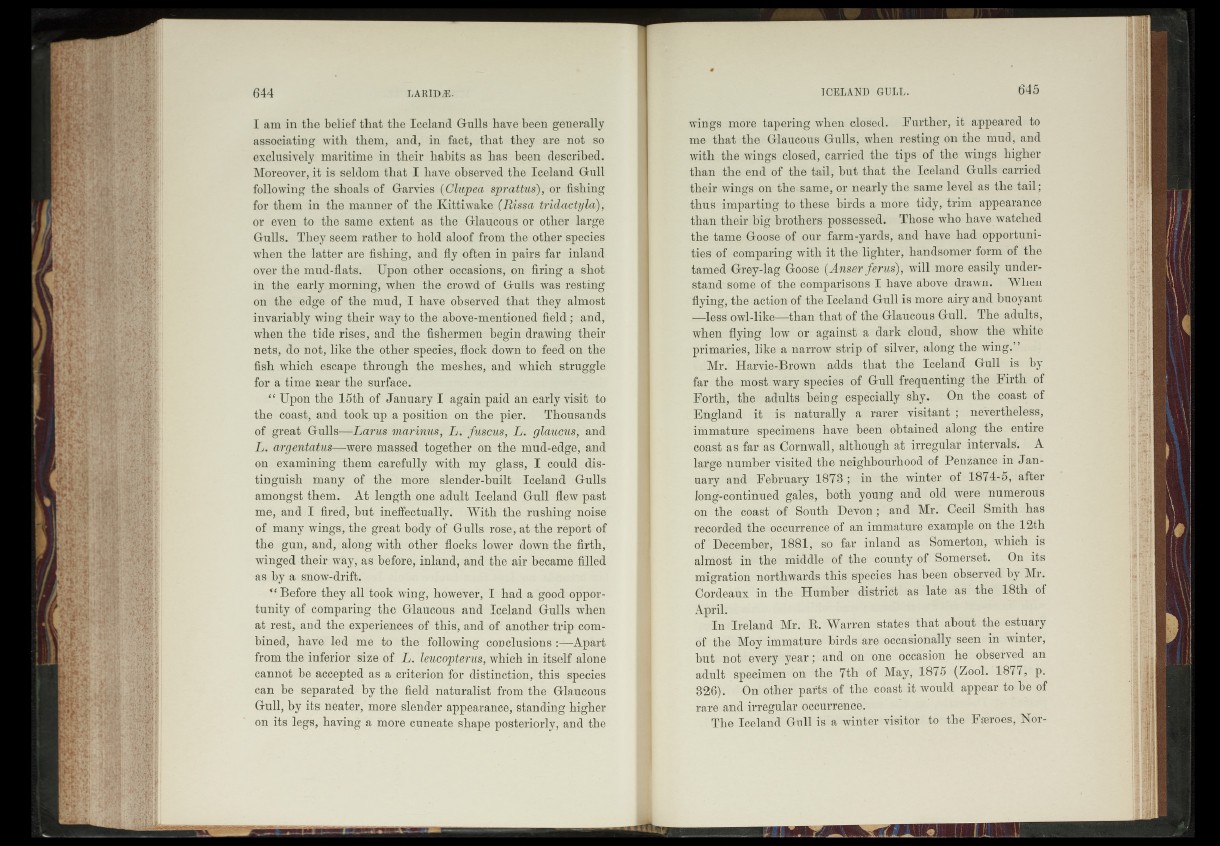
I am in the belief that the Iceland Gulls have been generally
associating with them, and, in fact, that they are hot >so
exclusively maritime in their habits as has been tdescribed-
Moreover, it is seldom that I have observed the Iceland Gull
following the shoals of Garvies (Clitpea sprattus}, or, fishing
for them in the manner of the Kittiwake (Bisscc tridactylai),
or even to the same extent as the Glaucous or other large
Gulls. They seem rather to hold aloof from the other species
when the latter are fishing, and fly often in pairs far inland
over the mud-flats. Upon other occasions^,jpte firing a shot
in the early morning, when th'e crowd of Gulls was resting
on the edge of the mud, I have observed that , they almost
invariably wing their way to;-the above-mentioned fields^ and,
when the tide rises, and ;the fishermen begin drawing -their
nets, do not, like the other species, flock down to.feedsoniAe
fish which escape through the meshes, and which struggle
for a time near thé surface.
Upon the 15th of January I again paid an early visit to
the coast, and- took up a position on .the/pier; .Thousands
of great Gullse^-Uarws marinus, Lr.'f fu'scus-, sËs; gXaucmy and
U; argentatus—were massed together1 on 'the: mud-edge, ’and
on examining them carefully with my..glass, I could,;distinguish
many of /the': mote j dénder-built Iceland Gulls
amongst them. At length one adult.Tcëland GulHflew past
me, and I fired, hut ineffectually. With the rushing-noise
of- many wings, the great, body of ;Gulls rose, at the report -of
the gun, and, along with other .flocks- lower dowmtbeefirth,
winged their way, as before, inland, andethe air became filled
as By a snow-drift,jj
Before they-all ’took: wifigy however, I had .ag^odvappor-
tunaty of comparing the Glaucous .and* Iceland Gulls, when
at .rest, and the experiences of this, and of another trip feefc
bined, have led-me to the following :con clusinn«%%-Apajt'
from the inferior size ó f L. le<ueopie.ru&;mhr<ïh initsfelf:alone
cannot- be accepted as a,„criterion for distinction, this species
can be separated by the field naturalist fromtt-he Glaufcous
Gull, by its neater, moré slender appearance; standing-higher-
on its legs; having a more cuneate shape posteriorly?andthe
wings more tapering when.;dcse^i! Further, it appeared; to
me tha t the Glaucous Gulls, when resting on the mud, and
with the wings closed, carried the tips of the wings ihigher
than th e end of the tail; hut tha t the Iceland GuSs- carried
their wings on- the-same, or nearly the same level as the tail;
thus imparting* to-these birds a mote tidy,, trim appearance
than theiihbig brothers possessed..: Those who have watched
the tame Goose of our_farm-yards, and have had opportunities
of comparing with it the- lighter”,’-handsomer form of .the
tamed Grey-lag'Gobsfe { A n s e v ^m ) ,^M - more easily understand
some of. the comparisons I have above drawn. When
'flying, the action ofithe Icelandr«Gull is more air-y and buoyant
t—less owl-.like—than th a t o f the. Glaucous Gull. The adults,
when flying low <or against .a daik«« cloud,. show • th e white
primaries, like a narrow strip-of silver, lalong th e witig.
#il’Mr.- Harvie-Brown addsctha t the Iceland Gull is by
far the- mq&Awarykpebiesiof Gull frequenting, the 'Firth of
Forth,ithe-: adults "-being especially shy. ’ On dhe*?'Coast -of
England it- ishmaturally a rarer-Vivisitanf :; g nevertheless-,
immature-speclmiens. have been- obtained along:',the. entire
coast as far as Cornwall; although at irregular- intervals. A
large nugnl||gf'viisited the -neighbourhood of Penzance.in J a n uary
and; F eb ru a ry 1873; ia'cth©- winter of 1874;-5, after
long-continued-igales;' both - young and old were: numerous
on -the boasts Mr South- Devon u iillM r . Cecil'. Smith has
recopded^ihe: occurrence of an immature example, on the 12th
of December,' 188fl§#ssO, far MlamU a s . :Somerton, which is
almost M- the middle: of the!^coua%cuf-Soinerset. On its
migration; northwards th is sp^cies-i has.:heen observed! by Mr.
(Bordeaux in the - -Humber district- as late as .-the’-18th of
April-.-
In Ireland Mr.' E. Warren states*that abBut, the-estuary
of the -Moy immature-birds iare occasionally seen in. winter,
hut n ot^evenyhffeaT.*;' and on to n e ’ occasion- he observed an
adult specimen-on^fbe-Tth: of Mayy 1815, (:Zool. !1B7'7,J p.
3“265i-^' On ether? parts -.o.#fhe %easfcTt would appear tobe -qf
rate- and. irreghUr-bccurren ce.
The IcelabdiGidf is 'a winter^isMorl to-'-tlre' Faroes, ^©r